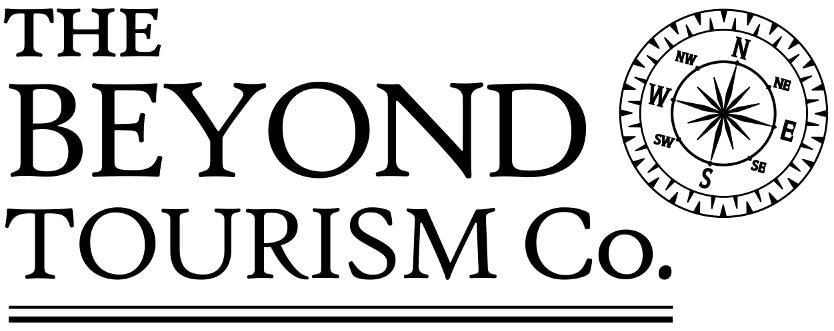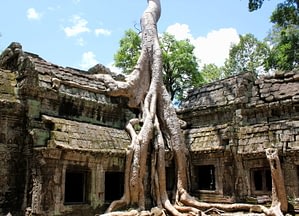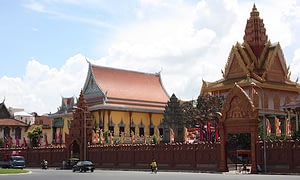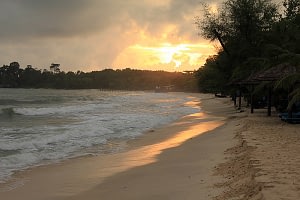Explore the wonderful highlights of Cambodia, from dense lush jungles to bustling cities and some of the best beaches in South East Asia. Read more below about our favourite places to discover during a trip to this diverse and lesser-visited gem. When you're ready to plan your own adventure, you can choose from our suggested itineraries and combine with our responsible experiences for an unforgettable holiday with a positive impact.
Mere words can’t do justice to Angkor Wat, one of the most spectacular temple complexes in Asia, a modern wonder of the world and the outstanding ‘must-see’ in Cambodia. Angkor Wat formed the religious heart and capital city of the ancient Khmer kingdom. It was one of the largest cities in the world in its day and the ruins now sprawl over a 400 sq km archaeological park. Many people visit on foot to soak up the atmosphere and peace of the place, but think about a taking a bike or even a horse to really get into the nooks and crannies and away from the crowds.
Reached from the nearby town of Siem Reap, Angkor Wat really demands at least 2 days of exploring, centred on the ‘small circuit’ and the ‘grand circuit’. On the small circuit you’ll find the most important central temples including the huge pyramid of Takeo and the jungle-clad Ta Prohm. We’ll also take you to the impressive Royal City of Angkor Thom where you will find the Bayon, a temple famed for its many gigantic carved faces that smile enigmatically down at you, and a host of other interesting sights like the Terrace of the Leper King.
Meanwhile, following the grand circuit will take you to Preah Khan or ‘Sacred Sword’, one of the largest temples at Angkor; Neak Pean, surrounded by fountains and ponds; and Ta Som with its famous strangler fig tree. There is also an option to visit the captivating and beautiful temple of BanteaySrei or ‘Fortress of the Women’, which boasts intricate pink sandstone carvings said to be too fine to have been made by men’s hands. It’s around 30km north, giving you time to soak up the beautiful Cambodian countryside and stop at some typical villages en route.
Angkor Wat repays the visitor prepared to ‘slow down, see more’ and there are many more beautiful sites scattered around to explore. You can spend as many days as you like but whenever you decide to leave, make sure to catch the awe-inspiring sight of sunrise over Angkor Wat before you get on your way. It’s an early start but we promise it’s worth it!
The Tonle Sap is the largest freshwater lake in South East Asia and an ecological hot spot that was designated a UNESCO biosphere in 1997. It encompasses a river system leading towards the Mekong that bizarrely changes its direction twice a year, flooding the lake and providing a rich source of nutrients for people and crops.
As a consequence, villages dot the lake not just round the edges but on the water itself. You’ll board a boat to sail through the traditional floating village of Chong Khneas and witness the residents going about their daily life. It is quite a sight to see a bamboo village complete with homes, petrol stations, schools, hair dressers and even karaoke bars floating on the lake! The boat will then head out into the wide expanse of the lake, cut its engine and allow you to experience the setting sun disappearing into the lake in silence. Bliss...
Bird-watchers will also be delighted by the Preak Toal bird sanctuary, which is known to be home to large colonies of spot billed pelicans, oriental darter, painted stork and greater adjutant stork. If you’re looking for some unique and high-quality souvenirs, we can also take you to the workshop of Artisans d’Angkor, where you can observe young Cambodians learning traditional Khmer handicraft techniques such as stone or wood carving, silk weaving and lacquering and gilding. The artisans are helping to rediscover the pride and culture of the country as it leaves its recent dark past behind and also to preserve it as tourism grows.
Cambodia’s capital is a fascinating city with a rich history, bustling markets and a vibrant new music and arts scene that is gaining international recognition. We’ve chosen some of the best responsible hotels for you to stay at, from where you can venture out to explore what the city has to offer. Our tours are run in conjunction with The Cyclo Centre, who will whisk you round the city by pedal power, giving you time to soak up the sights and sounds around you.
Your first stop should be the terracotta-red National Museum, which offers a charming setting for a comprehensive collection of Khmer artefacts. At the nearby Royal Palace, on the banks of the mighty Mekong river, you will be treated to the Throne Hall, the Chan Chaya Pavilion and the King’s residential quarters. Make sure you don’t miss the neighbouring Silver Pagoda, named after its floor which is decorated with an astonishing 4,000 silver tiles!
Cambodia is also known for its recent and harrowing history under the Khmer Rouge. The best place to get an insight into the regime and its impact is the Toul Sleng Genocide Museum, a former school located in a quiet Phnom Penh suburb that became a Khmer Rouge prison and torture centre known as S21. Afterwards a short drive 15km out of the city brings you to the infamous ‘Killing Fields’, now a powerful and moving memorial site located in a beautiful tranquil setting.
Other highlights include souvenir hunting at the Central and Russian markets, piled ceiling-high with colourful silks, cheap clothing and good Khmer antique reproductions, as well as the French quarter and Wat Phnom, which lent its name to the city. For the really brave, check out Skuon, also known as ‘Spiderville’ on account of the local delicacy - deep fried tarantula! Whatever you want to see or do, our knowledgeable guides can show you it through the eyes of a local and help you really get under the skin of this unique place.
Kep is a sleepy little town strung out along both sides of a peninsula right next to the Vietnamese border, on the south coast of Cambodia. It’s centred around a small cluster of restaurants and shops next to the beach, where locals gather to eat together on covered platforms looking out over the sea before collapsing into the numerous hammocks for the rest of the afternoon.
Kep makes a very pleasant alternative to the hustle and bustle of Sihanoukville’s public beaches and while the sands aren’t quite as white, the laid-back atmosphere and extremely fresh seafood will lure you in. Particularly good are the crabs found in abundance here, together with the world famous Kampot peppercorns that were ‘de rigeur’ on smart French tables for many years.
Many people plan for a couple of days in Kep but find themselves staying longer as they decide to stop and relax. However, there are quite a few things to do here too, such as:
• taking a tuktuk out to Kampong Trach to see the sleeping Buddha in the Caves
• visiting a natural pepper farm
• taking a leisurely walk around Kep Mountain with gorgeous views to Vietnam and seeing some tropical birdlife
• taking a boat out to Rabbit Island and spending the day snorkelling or having a barbeque on the beach.
All in all, if you’re after a bit of sun, sea and sand off the beaten track, Kep is well worth a look!
Although far less well-known than their Thai cousins, Cambodia’s beaches are just as spectacular and much less developed. Sharing the same turquoise water and jungle settings, the beaches on the south-west coast offer a tranquil and beautiful way to soak up the sun and unwind. They centre around Sihanoukville, a small town named after King Norodom Sihanouk, but deserted stretches of white sand can be found on islands stretching down the coast too, giving you plenty of space to relax.
If you want a break from lazing, Sihanoukville boasts fantastic scuba diving, especially around wrecks from Vietnam War, as well as some resort-based nightlife. You can also explore small islands nearby such as Koh Takieve, Koh Chroloh and Koh Russei where besides swimming and snorkelling, you can try local fishing techniques and enjoy a tasty barbeque lunch on one of the islands.





